When heavy weather hits, the last thing a skipper needs is the distraction of discomfort or worries over losing his footing. Effective foul-weather gear keeps you warm, dry, and able to face whatever Mother Nature has in her arsenal. And at the base of it all-literally-are quality sea boots. They conserve body heat, protect feet, and provide traction when getting around the boat can be seriously challenging.
As with most types of sailing gear-and all kinds of sailing apparel-picking the right sea boot is dependent on the end user and end use. A Caribbean cruiser will list different must-haves in a boot than an offshore voyager in the high-latitudes. (See “Buyers Checklist,” page 22.) With that in mind, testers sought out a variety of sea boots that covered the spectrum in construction materials, style, and of course, price.
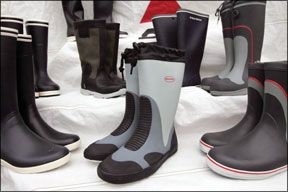
Photos by David Liscio
What We Tested
This test group included 15 pair of mid-calf, knee-high, and three-quarter sea boots from Aigle, Dubarry, Gill, Helly Hansen, Puma, Sperry, Ronstan, West Marine, and Musto. Our last look at sea boots (Sept. 1, 2002) highlighted 11 pair of boots, each costing less than $100, with the Musto boots getting the top pick. This go-around, only four were below the $100 price point. The others cost as much as $345, and construction materials ranged from simple rubber composites to advanced combinations of leather, Kevlar, and Gore-Tex. All have non-marking soles.
We tested only mens sea boots, but many of these could be considered unisex, provided they are available in small enough sizes. We put each boot through a series of tests, focusing primarily on impermeability and sole grip. (See “How We Tested.”)
What We Found
Boots on the lower end of the price spectrum tended to be clunky and made from more rubbery, less breathable materials. While many of these do quite well keeping the water out, they are generally less comfortable and wont last as long as some of the more expensive boots. For pure comfort, the Puma, Gill breathable leather Kevlar/Cordura , Aigle Racer GTX, Helly Hansen Helly Welly, Musto HPX, and both Dubarry models were superior, in our opinion.
Many of the sea boots tested had added features, ranging from boot-top drawstrings to fold-down outer gaiters. The Dubarry, Musto, and Gill Cordura boots incorporated loops at the rear to facilitate quick donning and doffing, an important feature in an emergency or if the wearer goes overboard. Some, like the Dubarry and Helly Welly, also had reflective material, but in no case was it significant enough to be considered a safety feature.
Aigle
Testers evaluated four pair of boots from French manufacturer Aigle: The mid-calf Racer GTX and the knee-high Glenan, Glenan ISO, and Skey. With the exception of the Racer GTX, the Aigle boots used Gomafix rubber, a supple, hyper-flexible material that is superior to the standard rubber used in less-expensive sea boots.
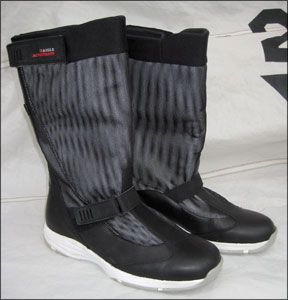
These boots, with their honeycomb-soles, were among the top performers in the traction test. However, the non-breathable rubber boots might leave feet sweaty, and we prefer boots with removable footbeds, which enable faster drying and help keep odors from developing.
Racer GTX: Aigles more advanced model, the Racer GTX combines leather and Gore-Tex in a flexible, breathable, and insulated boot. Unlike the other Aigles, these have adjustable Velcro tabs to accommodate easy entry and exit. The sole features a swirled band of raised, arrow-shaped grippers running front-to-back. Among the Aigle boots, this design proved to offer the least traction in bench tests. According to Aigle, the traction improves with wear and once the boots are broken in, the Racer GTX soles offer better grip than the honeycomb soles.
Glenan and Glenan ISO: When it came time to determine which boots would hold fast to both wet and dry nonskid fiberglass or teak decking, it was tough to beat the Glenan, Glenan ISO, or the Skey boots in our tests. All three use a honeycomb sole for grip. The only discernible difference between the Glenan and the Glenan ISO is the latters insulation. Its neoprene lining offers added comfort over the Glenan and Skey.
Skey: These flexible, non-breathable boots sport heavy stitching at the seam along the back. Testers reported chafing where this seam rubbed on socked skin.
Dubarry
The two Dubarry models we tested, the Newport and Ultima, feature high-performance leather treated to repel water and dry fast. Neither is insulated, but their Gore-Tex linings wick away perspiration and are woven tightly to be waterproof.
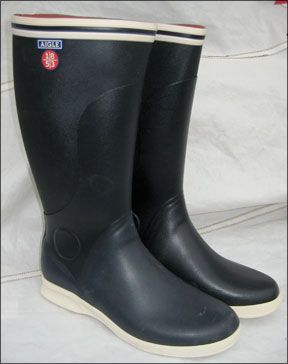
The three-quarter boots soles have a honeycomb pattern that proved very effective during traction tests. The soft outer hide-a cross between pull-up and nu-buck leather-is designed to dry fast and soft, resisting the tendency to crack, a problem typical of leather boots that see saltwater action.
Newport: Newly released by the Irish shoemaker, the lightweight Newport has the preferred features of removable footbeds and pull-on loops. However, testers noted that the Newports loops were quite small, which would be inconvenient when gloved hands are doing the donning.
Ultima: A traditional, handsome, brown leather and Gore-Tex boot made in Portugal, the Ultima offered better traction than the Newports in our tests and also features a removable footbed and a generous pull-on loop. Testers found the Ultima easier to put on than the Newport, and they are available in a wider-entry version.
Gill
We tested one pair of Gill boots in each of the height categories: the three-quarter breathable leather and Kevlar/Cordura (913), the knee-high tall yachting boot (909), and the mid-calf short yachting boot (901). All three performed well in traction testing, but surprisingly, the Vibram-soled breathable leather-Cordura boots had slightly less grip than its Gill counterparts on dry surfaces. None of them are insulated.

Breathable Leather and Kevlar/Cordura: Softer than rubber footwear, these boots are made of breathable leather and Kevlar, and are lined with E-vent fabric. E-vent material, taped for waterproofing, uses a proprietary membrane system to wick away sweat through millions of small pores. The Kevlar reinforcement offers good abrasion resistance, as does the double-layer toe section. Other notable features include the durable and flexible Vibram sole; lightweight, removable and padded footbed; and looped pull-on tabs. At $300, these were among the most expensive boots we tested. Gill also offers a plain leather version of this boot for $269, but we did not test this model.
Tall Yachting Boots: The beefy tall yachting boot is made of a stiff rubber composite with a fast-drying polyester liner. These and the short yachting boot are Gills standard-issue, entry-level sea boots. The removable inner sole is cushioned and has an arch support. The tall yachting boots also have a drawstring top with a soft rubber seal that reduces the likelihood of any water splashing inside the boots. These have molded, three-dimensional tread that fared well in our tests.
Short Yachting Boots: Unlike the tall Gill boots, these use multi-directional, wave-cut siping on the soles for grip. Their shorter height makes them easier to get in and out of than knee-high boots, and they have reinforced heels and toes for added protection. Testers found these boots somewhat stiff, but for your basic, no-frills rubber boot, the price is right: $50.
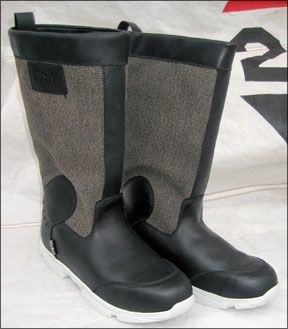
Helly Hansen
Helly Hansen, a Norwegian company with offices in Washington and Canada, makes sportswear for sailing, winter sports, and hiking/backpacking. We tested the HH marine boot, the Helly Welly.
Helly Welly: Testers noted that these boots have a unique Star-Trek look and that they are very tall, reaching to the knee joint. But their soft, flexible material makes it possible for wearers to roll them down to mid-calf, three-quarters, and other lengths. This lightweight boot is insulated and breathable, with sealed seams. Designed for offshore use, the Welly offers triple-stitched construction and a removable footbed.
While the Helly Wellys successfully got the Ericsson Racing Teams through the most recent Volvo Ocean Race, their Ultra Storm Grip outsole did not win top marks in our traction tests. Pushed to an extreme 45-degree angle, the Welly boots tended to slip on all but wet teak.
Musto
Musto is a performance-wear maker based in the UK, and its apparel is most prevalent among racing sailors.
HPX Ocean Boot: This three-quarter Musto boot combines leather and Gore-Tex with Kevlar for a soft, stretchy gaitor-style upper that testers rated very highly for comfort, waterproofness, and donning ease. Like the Helly Welly, the Musto has a soft stovepipe-style leg that may make it difficult to doff in a man-overboard situation.
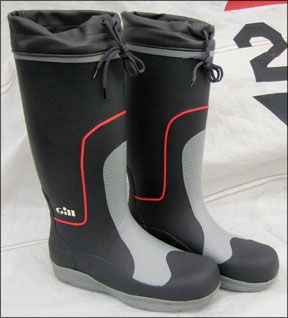
The GripDeck sole offers flexible footing, but it had a tendency to slip when pushed to a 45-degree angle during the traction tests, landing it in the middle of the pack in grip ratings. The Ocean Boot also features a removable, cushioned footbed, a Gore-Tex liner, a foam ankle protector, and a leather pull tab.
At $313, the Musto boot was the second most-expensive shoe tested.
Puma
Puma launched a line of sailing gear, distributed by Ronstan, with its sponsorship of Pumas il mostro in the most recent Volvo Ocean Race. Both Puma and Ronstan market a seaboot, but the two companies products are very different. The high-end Puma Luff is designed for extreme offshore conditions while the Ronstan boot is an inexpensive, basic rubber sea boot.
Puma Luff: The first thing testers noticed about these boots was their color: fire-engine red, also recognized as Puma red. For those of us more accustomed to traditional seaboots, the color was a bit off-putting, but the more flashy among our test panel like the bold footwear.
Aesthetics aside, the Luffs are quality boots that rated highly in bench and field tests. Made in Vietnam, the mid-calf leather boots were nearly as effective as the Irish Dubarry kicks in terms of traction. A series of swirling siping that runs front-to-back, vaguely resembling a contour map, provide excellent traction on wet and dry surfaces.

The Luff, the third most expensive test boot, also features a waterproof, breathable Gore-Tex liner and rubber reinforced toes for added protection from boat bites.
Ronstan
Ronstan, maker of sailboat hardware and sailing apparel, manufactures a very basic $65 pair of sea boots that is waterproof and comparatively lightweight.
Ronstan Sailing Boot CL66: A three-quarters boot, the Ronstan is made of reinforced neoprene, a non-breathable, stiff and rubbery material. While testers appreciated the features of the boot-including the removable footbed, rubber-reinforced toe and heel, and drawstring boot-top-it earned only a Fair for comfort. The boot has heavy soles and heavy seam stitching, which testers said caused minor chafing.
Although the boots thick neoprene lining adds some cushioning and warmth, they likely are better suited for more mild climates or coastal cruising conditions than for offshore use. The CL66 landed in the middle of the pack in grip tests.
Sperry
Well-known American footwear manufacturer Sperry Topsider has been synonymous with sailing shoes since the 1930s. We tested the companys Fathom boot, which is reportedly to be replaced by a new product later this fall, but the Fathom will still be available.
Fathom:Testers found the waterproof leather and nylon Fathom to be among the better-looking and most comfortable test boots. Sticking out from foul-weather pants, they look more like casual dress shoes than offshore armor, and theyre relatively lightweight to boot.
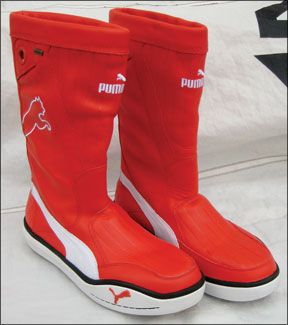
Protected with the funk-fighting AEGIS Microbe Shield, the removable molded footbed should resist odor-causing germs and dry quickly. The boots sport nylon gaitor-style tops with an elastic drawstring and plastic toggle to keep the weather out.
Sperry has a patented Quadro-Grip Traction wave-siping that runs front-to-back and side-to-side, similar to a quality tennis sneaker. The Fathom, which also features deep indentations that channel deck water and assist with traction, ranked among the top picks in traction testing.
With a $180 price tag, the Fathom falls in the middle of the group as far as price and is a great buy for the buck, in our opinion. Look for price breaks if a new shoe is introduced.
West Marine
Retail giant West Marine sells its private-label tall seaboots, which are made by Gill and are pretty close to identical to the Gill 902 tall boot, which we did not test.
Tall Cruising Boot (WM 8896953S): These knee-high natural-rubber boots are lined with quick-drying polyester. Testers found them stiff and uncomfortable after long hours of standing, despite their removable cushioned footbed.
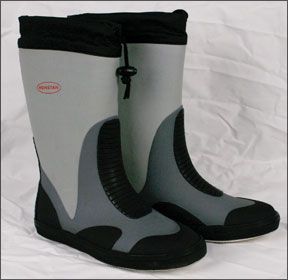
Like the Ronstan standard-issue boots, these basic boots are budget priced ($56). We do like that they come with reinforced heels and toes. Their razor-cut, multi-directional siping performed well on wet surfaces but only fair on dry. Surprisingly, this sole is the same as the Gill short yachting boot, which rated better in traction tests on dry surfaces. No design or construction component that we found could explain this difference.
For sailors for whom durability and price outweigh comfort, these are worth considering.
Bottom Line
Sea boots should be comfortable, waterproof, warm, quick to dry, easy to doff and don, and able to keep you from slipping off the deck. You don’t need to spend a small fortune to get a pair of durable boots with decent grip. However, if you want true comfort and top-of-the-line performance, expect to shell out $150 or more.
Across-the-board Excellent ratings earn the Dubarry Ultima our Practical Sailor Best Choice pick. The Sperry Fathom, with Good grip and Excellent comfort ratings, and the Aigle Glenan ISO, with Good comfort and Excellent grip ratings, both get a Practical Sailor Recommendation for an insulated boot. Just behind the Fathom in traction tests, the Musto HPX Ocean Boot is also an excellent insulated option but its nearly twice the price of the Fathom.
The Dubarry Newport and Puma Luff are unlikely to disappoint in any category and earned the Practical Sailor Recommendation for non-insulated boots.
For most of us, $150-plus is a lot of money to spend on shoes, but consider it an investment in comfort and safety. Sailors who can’t squeeze that much out of their budget or need only a basic rubber boot for more mild conditions should consider the Gill yachting tall or short boots, the Practical Sailor Budget Buy.





































